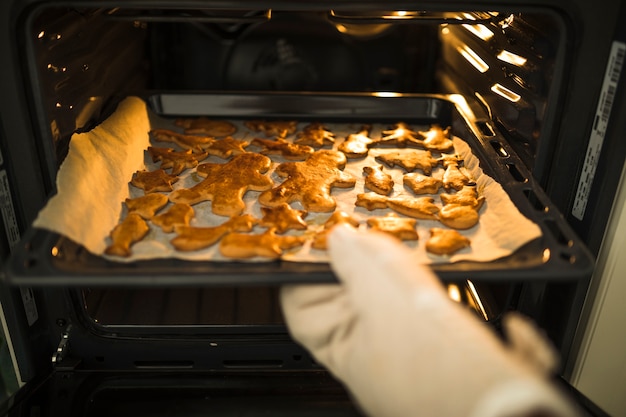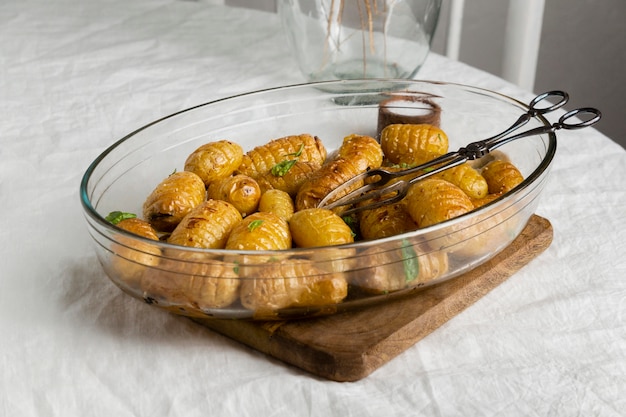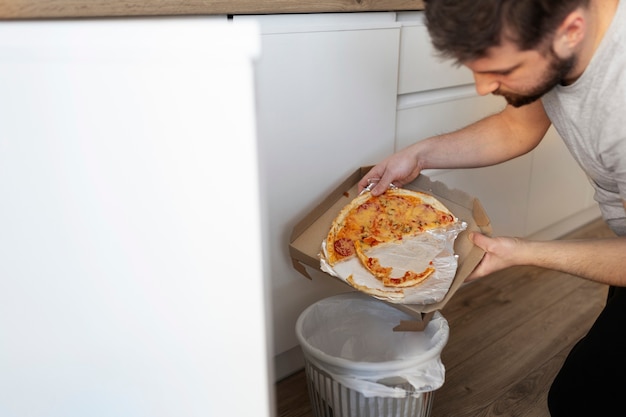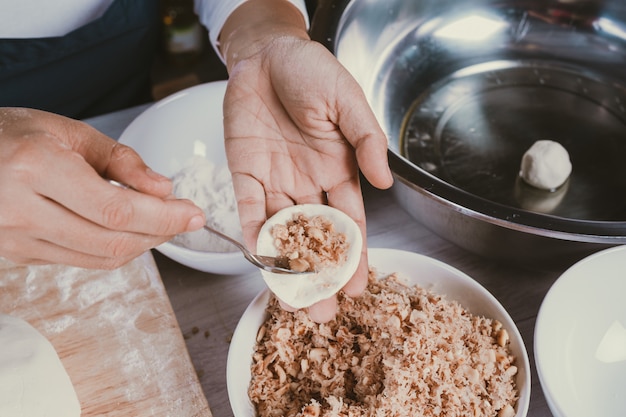(Part 1) Choosing the Right Spud

The Basics of Potato Selection
The first step to microwave potato success is selecting the right type of potato. It’s not just about any old spud; certain varieties are better suited to the microwave than others. You want potatoes that are relatively dense and starchy, as these will cook more evenly and hold their shape better. My go-to choices are usually russet potatoes or Yukon Golds. Russets are known for their fluffy texture and are ideal for mashed potatoes, while Yukon Golds offer a slightly buttery flavour and work well for roasted or baked potatoes.
When choosing potatoes, try to pick ones that are firm to the touch and have smooth, unbroken skin. Avoid any potatoes that have soft spots, green patches, or sprout growth. These are signs that the potato has started to spoil and won't cook as well.
What to Avoid
Here are a few potatoes to steer clear of for microwave cooking:
- Red Potatoes: They tend to be waxy and may not cook through evenly in the microwave. While they're great for boiling or roasting, their denser texture makes them less suitable for microwave cooking.
- Fingerling Potatoes: Their small size and thin skin make them difficult to cook evenly in the microwave. You'll likely end up with some soft spots and some parts that are still quite hard.
- New Potatoes: These are best suited for boiling or steaming due to their delicate skin. Microwaving them could lead to them becoming mushy and losing their flavour.
Size Matters
It goes without saying that the size of your potatoes will impact the cooking time. Smaller potatoes will cook quicker, while larger ones will take longer. To make things easier, aim for potatoes that are roughly the same size for more consistent cooking. You can always cut larger potatoes in half to ensure even cooking, just make sure to pierce each half with a fork.
Remember, uniformity is key to achieving that perfect microwave-cooked potato. If you’re working with a mix of sizes, you might need to cook them in batches.
(Part 2) The Art of Pricking

Why Piercing Matters
Now, here’s a crucial tip: always prick your potatoes before microwaving them. This might seem like a simple step, but it’s essential to avoid steam buildup and potential explosions in your microwave. Think of it as letting out the pressure valve to prevent a culinary disaster.
Imagine a potato as a balloon filled with steam. If you don't prick it, the steam has nowhere to escape and could cause the potato to burst open. Not only is this a mess, but it could also damage your microwave.
How to Prick Your Potatoes
You can use a fork or a sharp knife to pierce your potatoes. Make several holes all over the surface, ensuring they go through the potato’s flesh. It’s a good idea to prick them about 1/2 inch deep. If you have a potato with eyes, prick those too!
Some people recommend using a skewer to make deeper holes, which allows for more steam release. However, I've found that a fork or a knife works perfectly well. The key is to ensure that the holes are evenly distributed and go deep enough to allow the steam to escape.
(Part 3) Microwave Power and Cooking Time

Understanding Microwave Power
The power of your microwave will affect cooking time. Microwaves come in different wattages, so check your manual to see what yours is rated at. Generally, a higher wattage means quicker cooking times. For example, a 1000-watt microwave will cook faster than a 700-watt one.
Estimating Cooking Time
Here’s a general guide to estimate cooking times for different potato sizes:
| Potato Size | Cooking Time (1000-watt microwave) |
|---|---|
| Small (2-3 inches) | 4-6 minutes |
| Medium (3-4 inches) | 6-8 minutes |
| Large (4-5 inches) | 8-10 minutes |
Remember, these are just estimates, and your actual cooking time may vary depending on your microwave’s power and the potato’s density. It’s always best to check the potatoes for doneness with a fork.
If your microwave is on the lower end of the wattage spectrum, you may need to add a couple of minutes to the cooking time. On the other hand, if your microwave is a high-powered beast, you may be able to shorten the cooking time by a minute or two.
It's also important to note that these times are for whole potatoes. If you're cooking potato wedges or chunks, the cooking time will be significantly shorter.
(Part 4) Mastering the Microwave Potato Technique
Step-by-Step Guide
Here’s how to cook potatoes in the microwave:1. Prepare Your Potatoes: Choose potatoes of a similar size, wash them well, and prick them with a fork. 2. Microwave: Place the potatoes in a microwave-safe dish. You can add a few tablespoons of water to the dish to help steam the potatoes. However, I find that adding water is unnecessary unless you're cooking a large batch of potatoes.3. Cook: Microwave on high power for the estimated time based on the potato size. You can check the potatoes for doneness after half the estimated cooking time. 4. Check for Doneness: To check if your potatoes are cooked through, insert a fork into the centre. It should go in easily, and the potato should feel soft.5. Rest: Let the potatoes rest for a few minutes after microwaving to allow them to cool slightly and continue to cook. This will help the potatoes to become even more tender.
Tips for Even Cooking
To ensure your potatoes cook evenly, consider these tips:
- Rotate the Potatoes: During cooking, rotate the potatoes halfway through to make sure all sides are exposed to the microwave energy.
- Use a Microwave-Safe Cover: Covering the dish with a microwave-safe lid or plastic wrap can help to trap the steam and speed up cooking time. This can also prevent the potatoes from drying out.
(Part 5) The Telltale Signs of Doneness
Doneness Check
When your potatoes are done, they should be soft and fluffy throughout. You should be able to easily push a fork through them without resistance. They should also have a slight give when you press on them with your fingers.
If you find that the potatoes are still hard in the center, but the outside is starting to get soft, you may need to add a few more minutes of cooking time.
Signs of Overcooking
If your potatoes are overcooked, they will be dry and crumbly. The edges may also start to turn brown. If this happens, try steaming the potatoes for a few minutes to rehydrate them. You can do this by placing the potatoes in a steamer basket over a pot of boiling water for about 5-10 minutes.
Another way to rehydrate overcooked potatoes is to add a bit of milk or cream when you're mashing them. This will help to make them smoother and more moist.
Undercooked Potatoes
Undercooked potatoes will be firm and will not have a soft centre. Microwave them for a few more minutes, checking them for doneness every minute or so.
Undercooked potatoes can also be a little bit tough, so it's important to check for doneness throughout the cooking process. You don't want to end up with potatoes that are so hard that they're difficult to eat.
(Part 6) microwave potato variations
Mashed Potatoes
microwaving potatoes is a great way to prepare mashed potatoes. After cooking them, simply peel and mash them with butter, milk, salt, and pepper. For a smoother consistency, you can use a potato ricer or food mill.
For a more decadent mashed potato, you can add sour cream, cream cheese, or even a little bit of garlic. And for a unique flavour, try adding a dollop of pesto or some fresh herbs.
Baked Potatoes
You can also bake potatoes in the microwave. Simply prick the potatoes, wrap them in a damp paper towel, and microwave them on high power for the estimated time. Once they’re cooked, you can add toppings like cheese, sour cream, chives, or bacon.
To make your baked potatoes extra special, try topping them with a dollop of chili, a sprinkle of shredded chicken, or a mixture of sautéed vegetables.
Potato Wedges
Want crispy potato wedges? Cut your potatoes into wedges, toss them with olive oil, salt, and pepper, and microwave them on high power for about 5-7 minutes. You can also broil them for a few minutes to get extra crispiness.
For extra flavour, try adding some paprika, garlic powder, or onion powder to your potato wedges. You can also serve them with a dipping sauce, such as ranch dressing or blue cheese dip.
(Part 7) Tips and Tricks
Maximizing Microwave Potato Cooking
Here are some tips and tricks to get the most out of your microwave potato cooking:
- Use a microwave-safe dish: Choose a dish that is large enough to hold your potatoes comfortably.
- Don't overcrowd the dish: Leave some space between the potatoes so they can cook evenly.
- Rotate the potatoes: Midway through cooking, rotate the potatoes to ensure even cooking.
- Use a cover: A lid or plastic wrap can help steam the potatoes and speed up the cooking process.
- Experiment with seasonings: Get creative with seasonings like herbs, spices, garlic, or onions.
Troubleshooting
If your potatoes are not cooking evenly, you may need to adjust the cooking time or rotate them more frequently. If they are still not cooking evenly, try cooking them in smaller batches.
If you find that the potatoes are becoming too dry, you can add a tablespoon of water to the dish and cover it with a microwave-safe lid. Let the potatoes steam for a few minutes until they are more moist.
(Part 8) Recipes with Microwaved Potatoes
potato soup
This is a quick and easy way to make a hearty soup using microwaved potatoes. Simply cook some potatoes, then blend them with vegetable broth, milk, and your favourite herbs and spices.
You can also add some chopped vegetables, such as carrots, celery, or onions, to your potato soup. For a creamy texture, you can use a blend of milk and cream.
potato salad
microwave potatoes, then peel and dice them. Combine with mayonnaise, mustard, celery, onion, and your favourite seasonings for a delicious potato salad.
For a tangier potato salad, try adding some chopped pickles or a splash of vinegar. You can also add some chopped hard-boiled eggs or chopped bacon for extra flavour and texture.
Potato Hash
Sauté some onions and peppers, then add diced microwaved potatoes and cook until they’re golden brown. Serve with your favourite breakfast toppings.
Potato hash can be a great way to use up leftover potatoes. You can also add other ingredients to your hash, such as diced ham, sausage, or ground beef.
(Part 9) FAQs
What happens if I don't prick my potatoes before microwaving them?
If you don't prick your potatoes, they can explode in the microwave. The steam builds up inside the potato, and when it has nowhere to escape, the potato can burst open.
This can be a messy situation, and it could also damage your microwave. It's always best to err on the side of caution and prick your potatoes before microwaving them.
Can I microwave potatoes in their skins?
Yes, you can microwave potatoes in their skins. Just make sure you prick them well and wrap them in a damp paper towel to help them steam.
Microwaving potatoes in their skins can be a good way to cook them for baked potatoes, as it helps to retain moisture and flavour. However, it's important to note that microwaved potatoes in their skins may not be as crispy on the outside as those that are baked in the oven.
How can I tell if my potatoes are cooked through?
You can check the potatoes for doneness by inserting a fork into the centre. It should go in easily, and the potato should feel soft. You can also give the potatoes a gentle squeeze. If they feel firm, they need to cook a little longer.
If you're unsure, you can always cut open a potato to check for doneness. The inside should be cooked through and no longer have a raw center.
How long can I store microwaved potatoes?
You can store cooked potatoes in the refrigerator for up to 3-4 days. Store them in an airtight container or wrap them tightly in plastic wrap.
Refrigerated cooked potatoes can be used in a variety of dishes, such as potato salad, potato soup, or hash.
What are some other ways to cook potatoes besides microwaving?
There are many other ways to cook potatoes, including baking, roasting, boiling, and frying. Each method results in a different texture and flavour, so experiment to find your favourites.
Baking and roasting potatoes will give you a crispy exterior and a fluffy interior. boiling potatoes will make them soft and tender. And frying potatoes will give them a crispy exterior and a soft interior. No matter how you choose to cook them, potatoes are a delicious and versatile ingredient.
Everyone is watching

How to Cook Frozen Lobster Tails Perfectly: A Step-by-Step Guide
RecipesLobster. Just the word conjures up images of lavish meals, special occasions, and a taste of luxury. But let's...

Pigs in a Blanket Cooking Time: How Long to Bake for Perfect Results
RecipesAh, pigs in a blanket. Just the name conjures up images of those delightful little parcels of crispy pastry en...

Pork Fillet Cooking Time: How Long to Cook It Perfectly
RecipesPork fillet, or tenderloin as it's sometimes called, is a real favourite in our house. It's so versatile, and...

The Ultimate Guide to Tender, Juicy Pulled Pork
RecipesRight, let's talk pulled pork. It's one of those dishes that just screams "comfort food," doesn't it? I mean...

The Ultimate Guide to Cooking Delicious Frankfurters
RecipesLet's face it, we all love a good frankfurter. It's a classic, simple, and always satisfying. But let's be rea...
